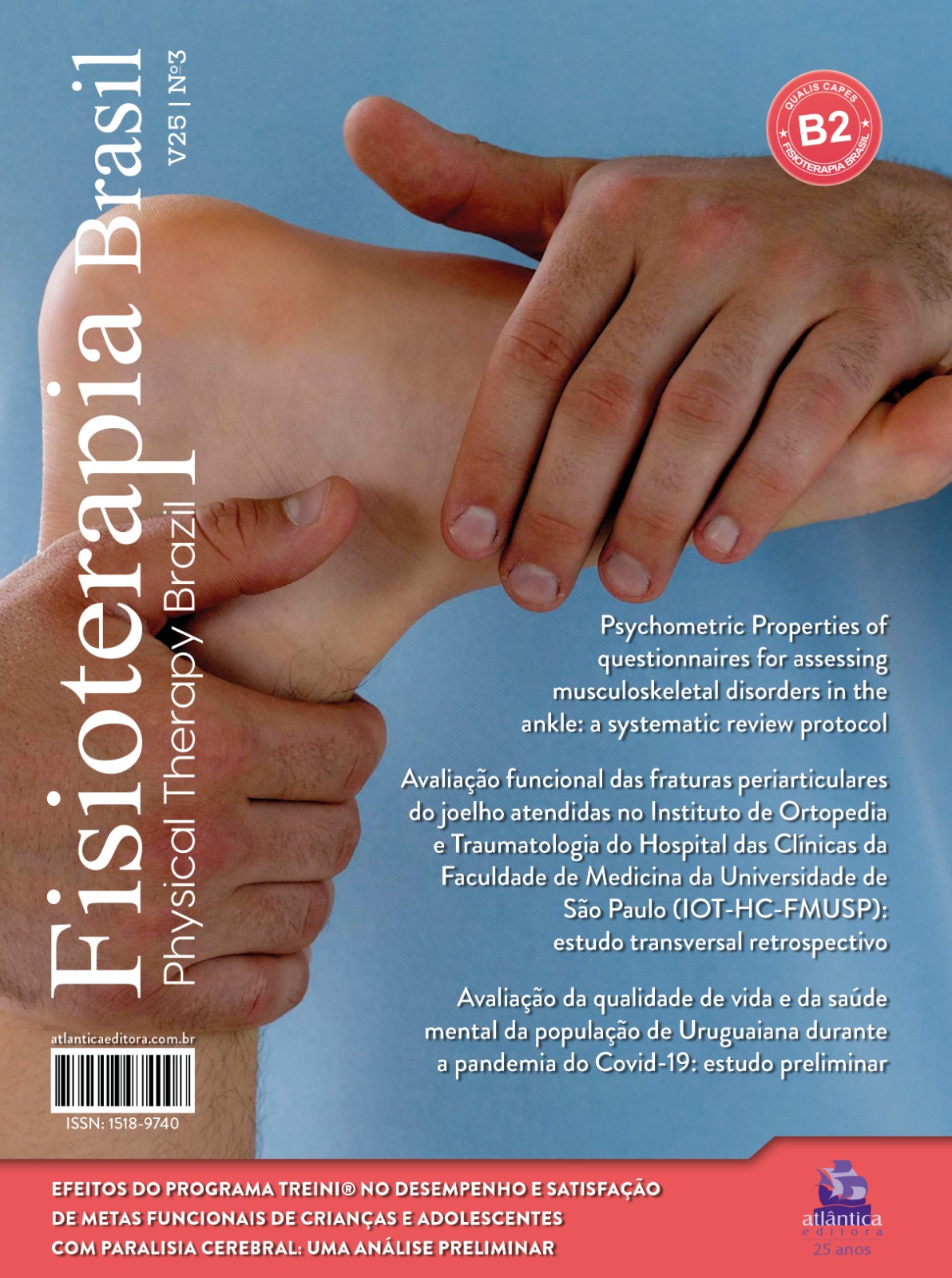Psychometric properties of questionnaires for assessing musculoskeletal disorders in the ankle: a systematic review protocol
DOI:
https://doi.org/10.62827/fb.v25i3.1001Palabras clave:
Ankle fractures; ankle injuries; patient-reported outcome measures; surveys and questionnaires.Resumen
Introduction: Ankle musculoskeletal disorders are common among various populations, including athletes and the elderly. However, there's a lack of specific instruments in the literature that address factors influencing the progression of these disorders. Objective: This review aims to identify and describe questionnaires focusing on these factors, emphasizing their psychometric characteristics, feasibility, and applicability across different populations. Methods: This study is a systematic review protocol developed according to PRISMA-P recommendations. Searches were conducted in various databases, including Medline, Embase, LILACS, PEDro, SCOPUS, CENTRAL, CINAHL, and Web of Science, without time limitation. The results will be analyzed using the Rayyan®️ software, where two researchers will conduct the identification and removal of duplicates, selection, and screening of studies, with discrepancies resolved by a third examiner. Results: The first phase will comprise reading titles and abstracts, followed by a full manuscript analysis. Methodological quality will be assessed using the COSMIN checklist. Psychometric evidence will follow Terwee et al. criteria. The overall synthesis score will combine the consistency of psychometric evidence with methodological quality, categorizing studies according to levels of evidence proposed by the Cochrane Musculoskeletal Group. The article eligibility process will be represented through the PRISMA flowchart, and results will be presented in tables and figures accompanied by descriptive and narrative analysis. Dissemination will include peer-reviewed publication and conferences in rehabilitation-specific contexts. Conclusion: This study aims to compile existing research to streamline the analysis and application of ankle joint assessment questionnaires recommended for clinical use. It will focus on identifying high-quality questionnaires and examining their ability to explore barriers and facilitators in rehabilitation processes.
Referencias
Debieux P, Wajnsztejn A, Mansur NSB. Epidemiology of injuries due to ankle sprain diagnosed in an orthopedic emergency room. Einstein (São Paulo). 2019;18.
Rocha S, Nicolle Aragão Fernandes, Wandscher B, Brito K, Leticya Sousa Teixeira, Júlia A, et al. Eficácia dos exercícios proprioceptivos na reabilitação pós lesão ligamentar do tornozelo em adultos: uma revisão sistemática. Fisioterapia Brasil. 2024 Jan 6;24(6):961–78.
Luciano A de P, Lara LCR. Estudo epidemiológico das lesões do pé e tornozelo na prática desportiva recreacional. Acta Ortopédica Brasileira. 2012 Dec;20(6):339–42.
De D, Terra D, Correa V, Mirelly B, Thompson De Oliveira. Análise das principais complicações em pacientes no pós-operatório de fratura de tornozelo: uma revisão. Brazilian Journal of Health Review. 2024 Jan 3;7(1):71–82.
Arnold BL, Wright CJ, Ross SE. Functional Ankle Instability and Health-Related Quality of Life. Journal of Athletic Training. 2011 Nov;46(6):634–41.
World Health Organization. Como usar a CIF: Um manual prático para o uso da Classificação Internacional de Funcionalidade. Centro Colaborador da OMS para a Classificação de Doenças em Português; 2013.
Johnston BC. Chapter 18: Patient-reported outcomes [Internet]. training.cochrane.org. 2023 [cited 2023 Jul 1]. Available from: https://training.cochrane.org/handbook/current/chapter-18
Al-Mohrej OA, Petrisor B. Foot and Ankle Outcome Instruments: Missing the Target. Current Reviews in Musculoskeletal Medicine [Internet]. 2023 Apr 4;16(6):246–54. Available from: https://www.ncbi.nlm.nih.gov/pmc/articles/PMC10234905/pdf/12178_2023_Article_9827.pdf
Hansen CF, Obionu KC, Comins JD, Krogsgaard MR. Patient reported outcome measures for ankle instability. An analysis of 17 existing questionnaires. Foot and Ankle Surgery. 2021 May;28(3).
Nguyen MQ, Dalen I, Iversen MM, Harboe K, Paulsen A. Ankle fractures: a systematic review of patient-reported outcome measures and their measurement properties. Quality of Life Research. 2022 Jun 18;32(27–45).
Mokkink LB, de Vet HCW, Prinsen CAC, Patrick DL, Alonso J, Bouter LM, et al. COSMIN Risk of Bias checklist for systematic reviews of Patient-Reported Outcome Measures. Quality of Life Research [Internet]. 2017 Dec 19;27(5):1171–9. Available from: https://link.springer.com/article/10.1007%2Fs11136-017-1765-4
Terwee CB, Bot SDM, de Boer MR, van der Windt DAWM, Knol DL, Dekker J, et al. Quality criteria were proposed for measurement properties of health status questionnaires. Journal of clinical epidemiology [Internet]. 2007;60(1):34–42. Available from: https://www.ncbi.nlm.nih.gov/pubmed/17161752
Ghogomu EAT, Maxwell LJ, Buchbinder R, Rader T, Pardo Pardo J, Johnston RV, et al. Updated Method Guidelines for Cochrane Musculoskeletal Group Systematic Reviews and Metaanalyses. The Journal of Rheumatology. 2013 Dec 1;41(2):194–205.
Descargas
Publicado
Número
Sección
Licencia
Derechos de autor 2024 Cauan Monteiro Costa, Ingrid Nazaré Lourinho Alves, Areolino Pena Matos, Ana Carolina Pereira Nunes Pinto, Natalia Iosimuta (Autor)

Esta obra está bajo una licencia internacional Creative Commons Atribución 4.0.
Autores que publicam nesta revista concordam com os seguintes termos:
Autores mantém os direitos autorais e concedem à revista o direito de primeira publicação, com o trabalho simultaneamente licenciado sob a Licença Creative Commons Attribution 4.0 que permite o compartilhamento do trabalho com reconhecimento da autoria e publicação inicial nesta revista.
Autores têm autorização para distribuição não-exclusiva da versão do trabalho publicada nesta revista (ex.: publicar em repositório institucional ou como capítulo de livro), com reconhecimento de autoria e publicação inicial nesta revista.



